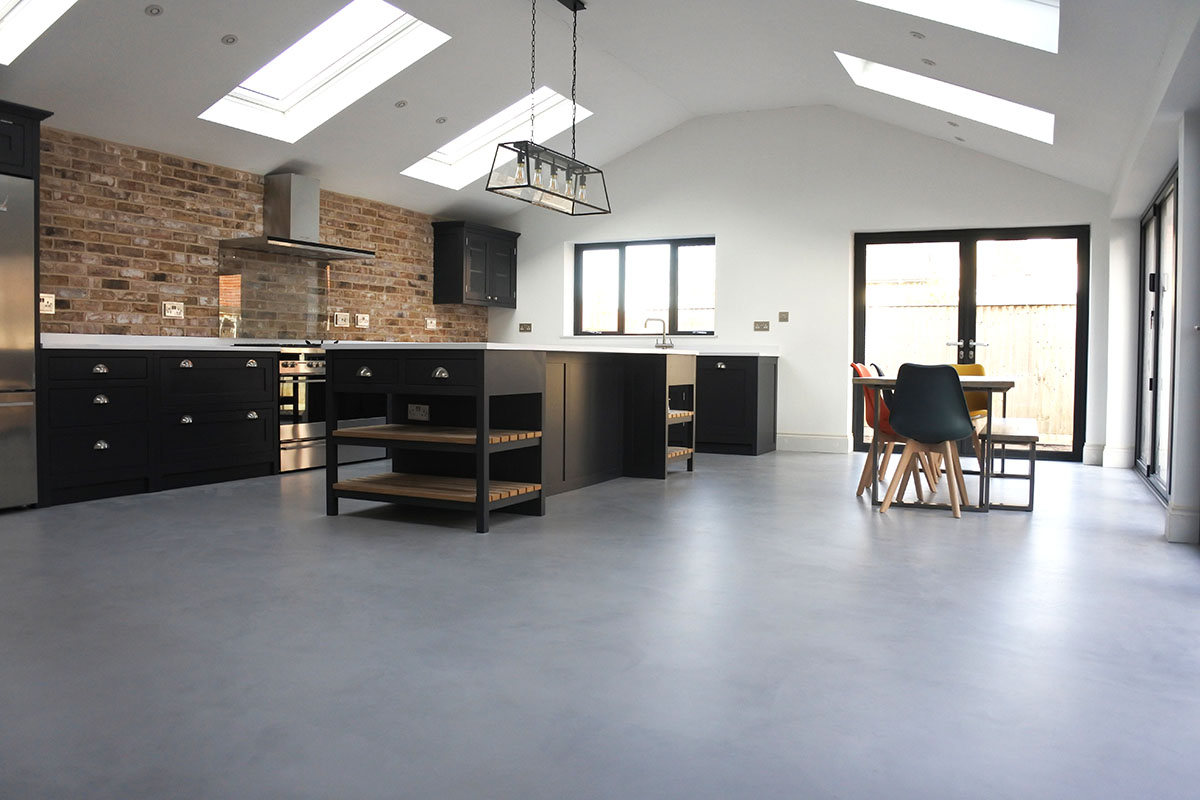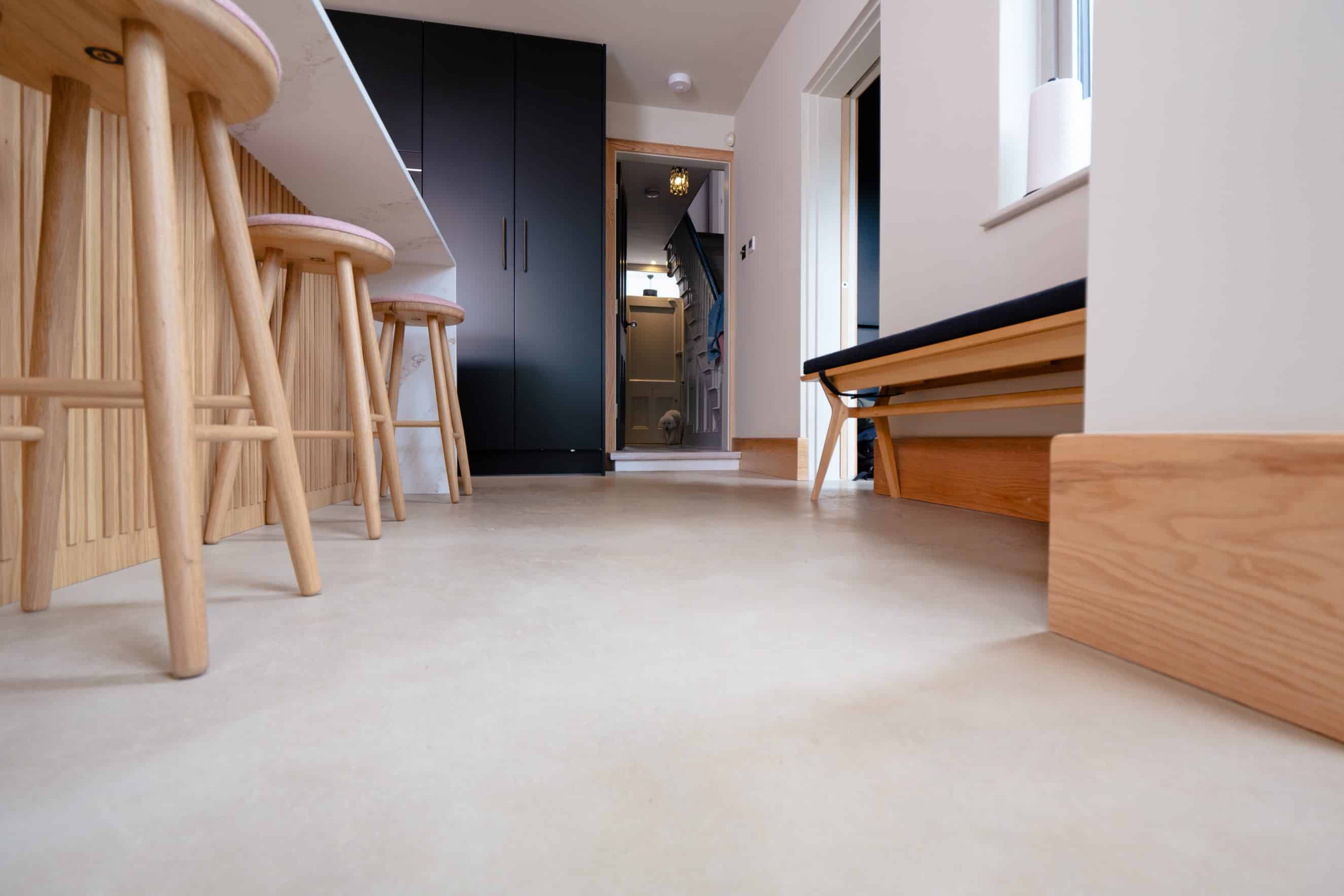Insights
Concrete Flooring vs Traditional Options: How Concrete Flooring Outperforms Other Options

Table of Contents
Introduction: The Rise of Concrete Flooring
Changing Attitudes and Growing Popularity
Concrete flooring has undergone a significant transformation. Once confined to industrial settings or relegated to garages and basements, it is now enjoying widespread adoption in homes and commercial spaces. This shift reflects a desire among homeowners and designers for a modern, practical flooring solution that doesn’t compromise on style. Today, concrete floors are being incorporated into living rooms, kitchens, offices, and retail spaces, where their contemporary yet elegant appeal shines.
From Functional to Fashionable
This growing popularity stems largely from changing perceptions of concrete. Previously dismissed as cold and utilitarian, it is now celebrated for its sleek, minimalist aesthetic. With a range of looks, from high-gloss modern to textured and understated, concrete has become a versatile option. Its customisation potential makes it suitable for both residential and commercial interiors, allowing for personalisation that sets spaces apart.

Why Concrete Flooring Stands Out
Durability and Practical Benefits
Concrete’s durability is one of its standout features, making it ideal for high-traffic areas in both homes and commercial properties. Unlike wood, which scratches, or vinyl, which can tear, concrete’s solid structure resists wear and tear. It also handles stains, moisture, and heavy use with ease, ensuring it remains attractive with minimal maintenance.
Environmental Appeal
Sustainability-conscious homeowners are drawn to concrete’s longevity and energy efficiency. Its extended lifespan reduces waste, while its thermal properties can help lower heating and cooling costs. All the materials for concrete are also procured locally which helps reduce carbon emissions. These benefits make concrete an increasingly popular choice for eco-friendly renovations.
The combination of durability, versatility, and sustainability firmly positions concrete as a top contender for flooring in British properties, offering a balance of practicality and style.
Unmatched Durability and Longevity
Standing Up to Daily Wear
Concrete flooring excels at resisting everyday damage. Unlike wood or vinyl, it doesn’t rely on a protective layer that can wear away. Polished concrete, in particular, resists scuffs and scratches, maintaining a smart appearance even in busy homes or commercial environments.
Resilient in the Face of the British Climate
The UK’s unpredictable weather, with its humidity, dampness, and temperature fluctuations, poses challenges for many materials. Concrete, however, does not warp, rot, or develop mould like timber. Modern techniques, such as expansion joints, allow it to adapt to temperature changes, reducing the risk of cracking. Proper sealing ensures it remains water-resistant and structurally sound, even in the dampest conditions.
Longevity Beyond Traditional Options
While carpets and vinyl may need replacing every 10–20 years, and wood often requires refinishing, concrete flooring can last up to 100 years, or even longer with proper care. This longevity reduces the need for repairs or replacements, offering excellent value over time.
Effortless Upkeep
Compared to traditional options like hardwood or carpet, concrete flooring requires minimal maintenance. Wood floors demand refinishing and are vulnerable to water damage, while carpets trap dirt and allergens. Concrete, by contrast, is easy to clean and doesn’t harbour debris, thanks to its seamless surface.
Simple Cleaning Methods
Routine care involves sweeping or vacuuming, with occasional mopping using warm water and a PH neutral cleaner. For stubborn dirt, a pressure washer or scrubber can be used, though most households find basic tools sufficient. This ease of cleaning makes concrete particularly appealing in kitchens, bathrooms, and high-traffic areas.
Resistance to Stains and Bacteria
When sealed properly, concrete floors resist stains, bacteria, and odours. Spills from food & drink can be wiped away without causing lasting damage. This makes concrete a hygienic option for homes and commercial spaces alike.
Versatility in Design and Application
Diverse Finishes to Suit Every Space
Concrete flooring offers a wide array of finishes, from polished and stained to patterned and textured. Polished concrete suits modern interiors, while stained or stamped finishes can replicate traditional materials like wood or stone. Textured surfaces add slip resistance, making them ideal for both indoor and outdoor use.
Adaptable for Homes and Businesses
Concrete’s versatility makes it suitable for nearly any environment. In homes, it works well in living rooms, kitchens, and bathrooms, while in commercial spaces, it withstands heavy foot traffic and equipment use. Its seamless, easy-to-clean surface is particularly valuable in spaces where hygiene is critical.
Blending with Any Interior Style
Whether your taste leans towards modern minimalism or classic elegance, concrete flooring can be tailored to match. Polished finishes complement contemporary spaces, while stained or patterned designs add warmth to traditional interiors. Decorative overlays and embedded designs further expand the creative possibilities.
Sustainability and Energy Efficiency
Reduced Waste Through Longevity
Concrete’s longevity minimises waste by reducing the frequency of replacements. This stands in contrast to materials like carpet or vinyl, which contribute significantly to landfill over time. Its durability also conserves resources, making it a more sustainable choice.
Compatible with Underfloor Heating
Concrete pairs naturally with underfloor heating systems, thanks to its excellent thermal conductivity. Heat is distributed evenly, creating a comfortable and energy-efficient environment while reducing reliance on radiators.
Thermal Mass for Energy Savings
Concrete’s thermal mass helps regulate indoor temperatures. It absorbs warmth during the day and releases it at night, reducing heating needs in winter. In summer, it helps maintain cooler interiors, reducing the demand for air conditioning.
Cost-Effectiveness Over Time
Long-Term Value
While the upfront cost of concrete flooring may be comparable to hardwood or tile, its low maintenance and longevity offer significant savings over time. There’s no need for frequent refinishing, deep cleaning, or replacement, making it a cost-effective option.
Adding Property Value
Concrete flooring enhances property value by offering a durable, modern feature that appeals to buyers. Its customisable finishes and long lifespan make it a practical and stylish upgrade, particularly in high-traffic areas.
Addressing Common Concerns
Managing Temperature
Concrete floors can sometimes feel cool underfoot. However, this can be addressed during the installation process by incorporating insulation boards beneath or above the slab, alongside a damp-proof membrane. This not only helps retain warmth but also ensures compliance with UK Building Regulations, achieving a U-value of 0.25 W/m²K or lower. This is especially beneficial for ground floors, where insulation reduces draughts and improves overall indoor comfort.
For those looking to enhance comfort further, underfloor heating systems can be seamlessly integrated during the installation of concrete flooring. Wet (water-based) systems work effectively with concrete’s thermal conductivity, distributing heat evenly across the surface. Wet systems are often preferred for larger spaces and long-term energy efficiency. Regardless of the choice, combining underfloor heating with insulated concrete ensures a warm, comfortable environment year-round.
Preventing Cracks and Moisture Issues
Modern installation methods, including expansion joints and vapour barriers, minimise the risk of cracking and moisture problems. Sealing the surface protects against damp and mould, ensuring longevity and structural integrity.

Conclusion
Concrete flooring has firmly established itself as a superior option for both residential and commercial properties in the UK, blending style, durability, and functionality in a way that few other materials can match.
Key Strengths of Concrete Flooring
Concrete floors offer unparalleled durability, standing up to wear, stains, and moisture far better than traditional materials like wood, carpet, or vinyl. This resilience makes it especially suitable for the UK’s variable climate, where dampness and temperature fluctuations can cause issues for other flooring types.
Practicality and Design Versatility
Concrete’s low maintenance requirements make it an ideal choice for busy households and commercial spaces. Its seamless surface resists spills, odours, and bacteria, while its extensive range of finishes, from polished to textured, ensures it can complement both modern and traditional interiors. This versatility allows homeowners and businesses to create spaces that are as unique as they are functional.
Environmental and Energy Benefits
From a sustainability perspective, concrete flooring stands out. Its longevity reduces waste associated with frequent replacements, and its natural thermal mass helps regulate indoor temperatures, lowering energy consumption. Additionally, the integration of underfloor heating systems, whether wet or dry, during installation enhances comfort and energy efficiency, making concrete an environmentally conscious and practical choice.
Key Considerations for Installation
Concerns about comfort and temperature control can be easily managed with thoughtful planning. Insulation, damp-proof membranes, and underfloor heating ensure a warm, comfortable surface, while modern techniques such as expansion joints and sealing prevent cracking and moisture issues.
Why Concrete is the Future of Flooring
Concrete flooring is more than a trend; it’s a long-term investment. Its durability, customisation options, and sustainability make it a practical and stylish choice for today’s homeowners and businesses. With proper installation and minimal maintenance, concrete floors deliver decades of performance, value, and visual appeal.

